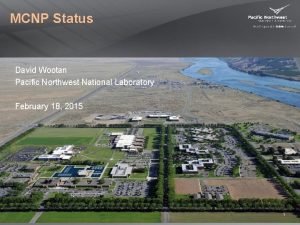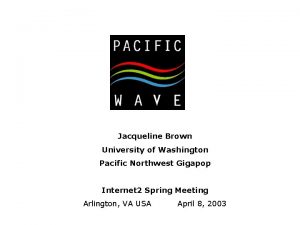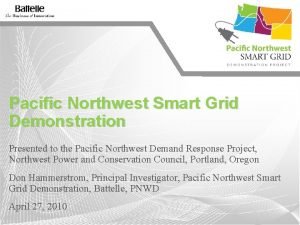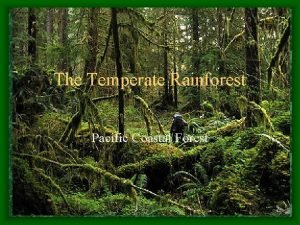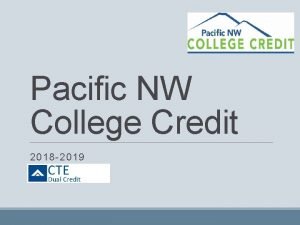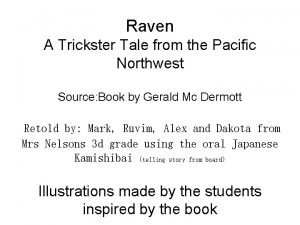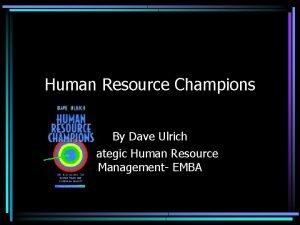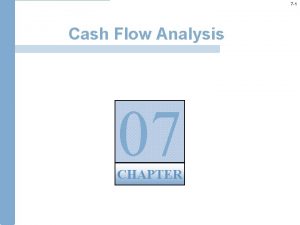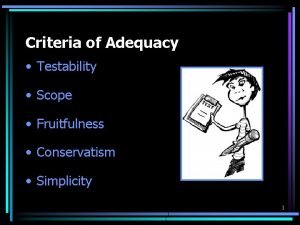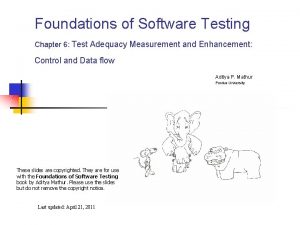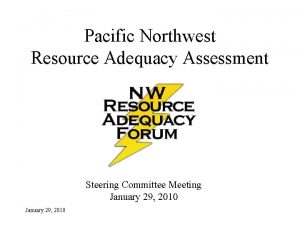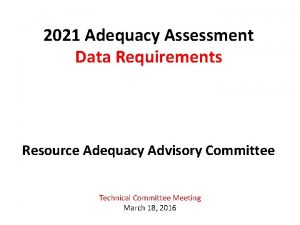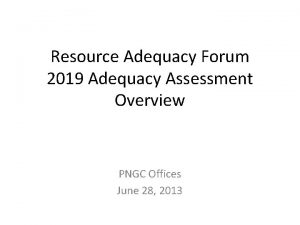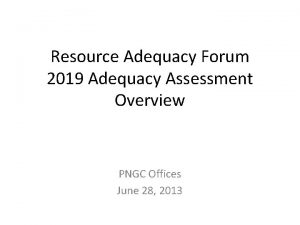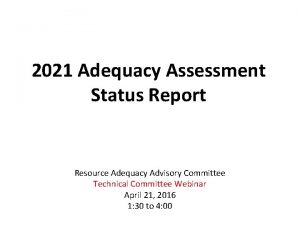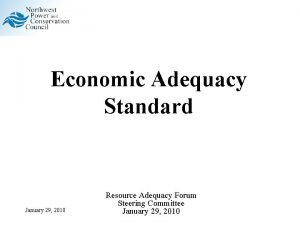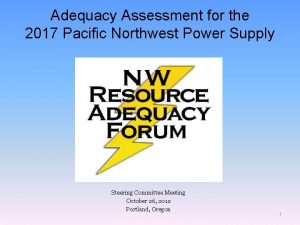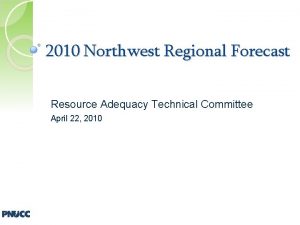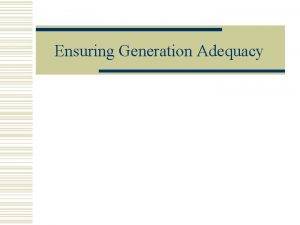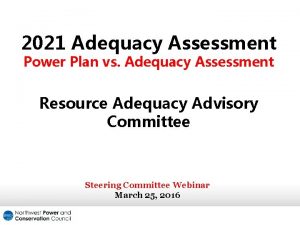Resource Adequacy in the Pacific Northwest Dave Angell

















- Slides: 17

Resource Adequacy in the Pacific Northwest Dave Angell WECC Member Advisory Committee Meeting March 10, 2020

Adequacy • To supply consumers power and energy at all times, accounting for scheduled and expected unscheduled This Photo by Unknown Author is licensed under CC BY-NC-ND This Photo by Unknown Author is licensed under CC BY-SA 2

Adequate Level of Reliability – Normal Conditions The state that the design, planning, and operation of the Bulk Electric System (BES) will achieve when the following reliability performance objectives are met: • Under normal operating conditions and when subject to predefined disturbances • No instability, uncontrolled separation, cascading, and collapse • Frequency and voltage are maintained This Photo by Unknown Author is licensed under CC BY-SA 3

Adequate Level of Reliability – Larger Disturbances • Following low probability disturbances, adverse reliability impacts are managed • Coordinated and controlled restoration occurs after major system disturbances YOU HAVE BEEN HACKED! 4

North America overview Energy Only Market • AESO • ERCOT an Newfoundland Alberta tchew AESO Labrador Manitoba Saska British Columbia PEI Quebec Ontario IS ONE Northwest MISO O NYIS Basin ia O ISrn ifo Cl. A Ca Rockies SPP Desert Southwest Bilateral Resource Adequacy Program • CAISO • SPP Nova Scotia New Brunswick Voluntary Central Capacity Market • MISO PJM VACARSouth ERCOT CC FR Central Capacity Market • PJM • NYISO • ISO-NE

Pacific Northwest Region in Transition

Studies confirm that the NW is approaching capacity shortfalls NW Capacity Surplus / Deficit in Recent Studies Northwest resource adequacy is a winter issue US WECC Coal Retirement Scenarios Developed from announced and potential retirements from across the WECC

Current practices may not be sufficient to maintain reliability in the Pacific Northwest

IRP needs assessment method Weighted by number of utilities Weighted by peak load Other stochastic 1 -outage-in-10 years Other stochastic (1) Deterministic (5) Deterministic / percentile 1 -outage in-10 years (3) Percentile Loss-of-loadprobability Data from IRP survey. Missing data filled in when possible. Deterministic/p ercentile (1) Loss-of-load probability (3) Percentile ([VALUE])

Market reliance, yes! 2025 market reliance MW (non-coincident) 1 800 SUMMER WINTER 1 600 MW/a. MW (peak or HLH) Season of highest use Total market available 1 400 1 200 1 000 800 600 400 200 0 1 Data from IRP survey. Missing data filled in when possible. 2 3 4 5 6 7 8 9 Utility 10 11 12 13 14 15 16

Wind & solar peak contribution varies Depends on: • Location • Season of stress • Existing portfolio • Analysis method Missing data excluded. Blanks are zeros.

Work Group Recommendations 1. The region should take further steps to develop a regional resource adequacy program to achieve the following benefits: To maintain reliability during a period of significant regional transition To increase transparency and uniformity for a clear understanding of the region’s resource adequacy position To reliably realize the full benefits of the existing load and resource diversity To provide a platform for shared planning reserves and optimal use of existing resources

Work Group Recommendations 2. The program design should be tailored to reflect the region’s uniqueness Hydroelectricity Public power Transmission and fuel delivery constraints 3. The program should not usurp utilities’ authority to plan for resource adequacy requirements Binding commitments on each member to do its share and must have exclusive authority over resource capacity accreditation Resources procurement retained by utilities

Evaluating The RA Framework Program Participation Program Design › NWPP footprint › Standardized › Centralized entity regional RA metrics administrating and executing › Forward showing the RA program period › Validates annual › Rules and bylaws showings and deficiencies › Operating program to unlock diversity › Enforces the benefits/ program investment savings › Includes an independent evaluator process › BA/LSEs, IPPs, IOUs, PUDs › Voluntary entry and program commitment › Compliance obligation Program Administration Structural Framework Regulatory Framework Understanding the legal framework and government structure › Ensuring regulation meets state and federal jurisdiction › Regulators and stakeholders gain insight into the regions RA position

Committees exist within the NWPP EXECUTIVE COMMITTTEE Set mission/vision; approve policy decisions EXECUTIVE ADVISORY COMMITTTEE Sounding board / program champions FRANK AFRANJI Stakeholder Advisory Committee Public Webinars STEERING COMMITTEE Execute the mission/vision; recommend policy

Resource Adequacy Program Design Project (RAPDP) Overview of Project Timeline Phase 1: Information Gathering (concluded Oct. 2019) Phase 2 A: Preliminary Design Phase (Early 2020) Phase 2 B: Detailed Design (Late 2020) Phase 3: Implementation Work (2021)

Thank you! https: //www. nwpp. org/resources/
 Prenhd
Prenhd Pacific northwest gigapop
Pacific northwest gigapop Pacific northwest smart grid demonstration project
Pacific northwest smart grid demonstration project Pacific northwest rainforest
Pacific northwest rainforest Pacific northwest food
Pacific northwest food Intermix
Intermix Serial killers pacific northwest
Serial killers pacific northwest Pacific northwest college credit
Pacific northwest college credit Raven: a trickster tale from the pacific northwest
Raven: a trickster tale from the pacific northwest James angell funcionalismo
James angell funcionalismo Utilitrio
Utilitrio Kjetil kjerstad
Kjetil kjerstad Hr champions dave ulrich
Hr champions dave ulrich The number of test of adequacy is
The number of test of adequacy is Certificate of adequacy
Certificate of adequacy Cash flow adequacy ratio
Cash flow adequacy ratio Criteria of adequacy fruitfulness
Criteria of adequacy fruitfulness Condition coverage
Condition coverage
